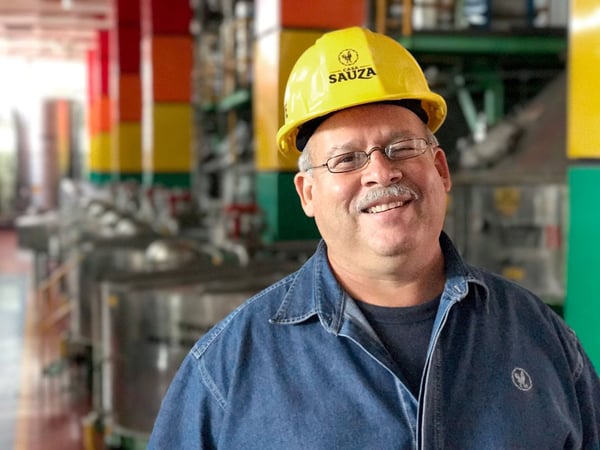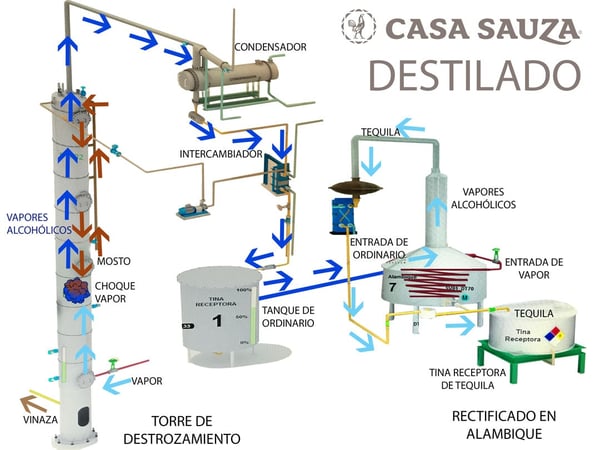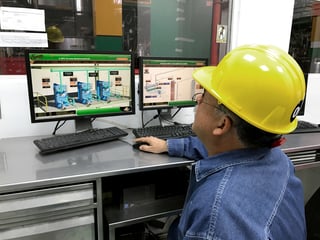
I've been collaborating at Casa Sauza as a distiller technician for more than 37 years and the information I boast about the most, is that some of our tequilas are triple distilled tequilas, like our Tres Generaciones Plata, for example. Let me share this knowledge with you so next time you have one of our triple distilled tequilas, you know you are getting the real thing, for sure.
About myself
Many years had to pass before I made it to the distillation area. My growth in the company is something I brag about and makes me feel proud since, like many other of this company's collaborators, I started at a very young age, as cleaning staff. My enthusiasm for learning more, my working perseverance, and the opportunities that Casa Sauza gave to me, made my growth in the company possible. I increasingly became more interested in all the different areas and started learning about them, until I finally arrived to the one I liked the most, distillation. I am proud to produce such a clean, refined and pure tequila.
What does a tequila distiller technician do?
A distiller technician is responsible of distilling which, in a very simplified way, means he separates the different components that make a liquid mixture up.
Tequila Distillation Process
1. Shattering
Distillation is a two-step process, the first one is called shattering. It is carried out in shattering towers at which we extract the alcohols that the agave's fermented juice has. This towers are made up by a series of discs aligned like a waterfall. The must if poured from the top and at the bottom, there is vapor. The vapor that we inject at the bottom of the tower generates an impact with the liquid and when the alcohols warm up, they go to the top of the tower. This is how we separate the substances that the liquid contains, which are distributed in the discs.
These alcoholic vapors go through their first transformation in a temperature condenser where they are turned back into liquid. Since this liquid is at that point, way too hot, we cool it down in another exchanger that lowers its temperature to 26 ºC (78.8 ºF). This liquid is gathered in cauldrons of concentrated alcohol, which we call tanks of "ordinary". The alcohol here is not drinkable yet, not completely innocuous.

2. Rectification
The second step of the distillation process is rectification. We do it in stills and we separate it by batches (batch distillation). The stills are filled with 4,000 liters of "ordinary" and the distillation principle is the same as the first one. The difference lies in the distillation by batches, since the alcohol is no longer continuously distilled like it was in the towers. The vapors here arrive at a heat exchanger where they are once again condensed and poured as liquid in a receptive tank.
The first minutes of the distilled product are known as heads or tops. We usually give 2 min for the recollection of the heads, which are immediately discarded since they contain very harmful alcohols. After this 2 minutes we concentrate our distilled product and gather it until we finally get the degree of alcohol that we want for each kind of tequila.
The first alcohol we obtain has above 80% to 90% alc. vol. The more distillation time passes by, the less alcohol concentration the drink has. We then go on until we reach to the degree of alcohol that we want, depending on the kind of tequila we are producing, which depends on the order that we receive, since it could be, for example of a 63% alc.vol. This part of the process is what we call the heart (tequila).
When we finally reach the desired concentration of alcohol, we proceed to make a "cut" so we separate what we call the tail, which is a liquid that has a a very low concentration of alcohol, up to the point where it reaches the 0%. We also get rid of tails and never use them in our tequilas.
Tequila's third distillation
As I mentioned at the beginning, we carry out a third distillation process for our Tres Generaciones Plata tequila. We use the heart of the rectification and put it back in the stills. We are not distilling "ordinary" here, we are distilling tequila to get an even more refined product. We distill the heart of the tequila's heart.

"Headed Tequila" and "Tailed Tequila"
We can say tequilas are "headed" or "tailed" when parts of the heads or tails were used in the final product. To us, that is a defect on a tequila, since it changes the properties and taste that a tequila should have.
For instance, a good tequila should taste like cooked honey or cooked agave. We should even be able to find fruity aromas. The more a tequila is headed or tailed, the more it'll loose this natural aromas and instead, it will start smelling and tasting like grass, like a dirty cloth or even like fuel.
How has distillation progressed with the passing fo the years?
We have always worried about improving and optimizing our distillation process. We used to distill everything in stills at the beginning. We then incorporated columns that we called "alcohol towers" to our process. Later on, we switched to the shattering towers that we now have. The advantage that these towers present, is that they carry out a continuous process that achieves a more accurate profile of the tequila that our company wants to offer.
In the tower we obtain the liquid by gravity and continuously. Before, with the stills, we had to make several loads and stop every once in a while in order to empty them for the rectification. Plus, the energy cost was higher because we had to pump the stills. In the towers, gravity does this job instead.
We have also improved our cooling devices with a more efficient equipment so we now have less alcohol leaks and also save water. We have also paid attention to all the little details in terms of improving our ideal temperatures and pressures in order to, once again, avoid wasting alcohol. We are constantly working with our lab, checking and analyzing samples of the processes that we make.
Quality in the distillation of tequilas
The constant monitoring of times, pressures and temperatures is what makes us preserve the quality of our the distillates. This is part of my job, one of my responsibilities, along with collaborating with the laboratory, where our products are analyzed during each stage of the process, as well as when we obtain the "ordinary".
Based on these laboratory tests, we decide, for example, to apply more or less pressure on the keys, to raise or lower the percentage of alcohol, or to change the time periods of each process.
These days, I control it all from the office where I program and monitor everything by means of modern automated equipment. The whole process can be supervised from a single place, without having to physically walk around all of the process' areas or manually measure the performance of everything.

My experience is the result of the training I have received and the time I have spent working at Casa Sauza. I am the fourth generation in my family that works at Casa Sauza. I am a "tequilero" by tradition and I am Sauza by conviction. My grandfather started working here since the 1920s and then, my parents, uncles and I have followed his steps, working for this company. It's very likely that one of my children will too. I have belonged to Casa Sauza for 37 years now and I am proud of it.
Want to know more about tequila? Visit Casa Sauza´s guided tours in Tequila, Jalisco.
.png?width=50&height=50&name=10.CS-Redondo%20(1).png)


